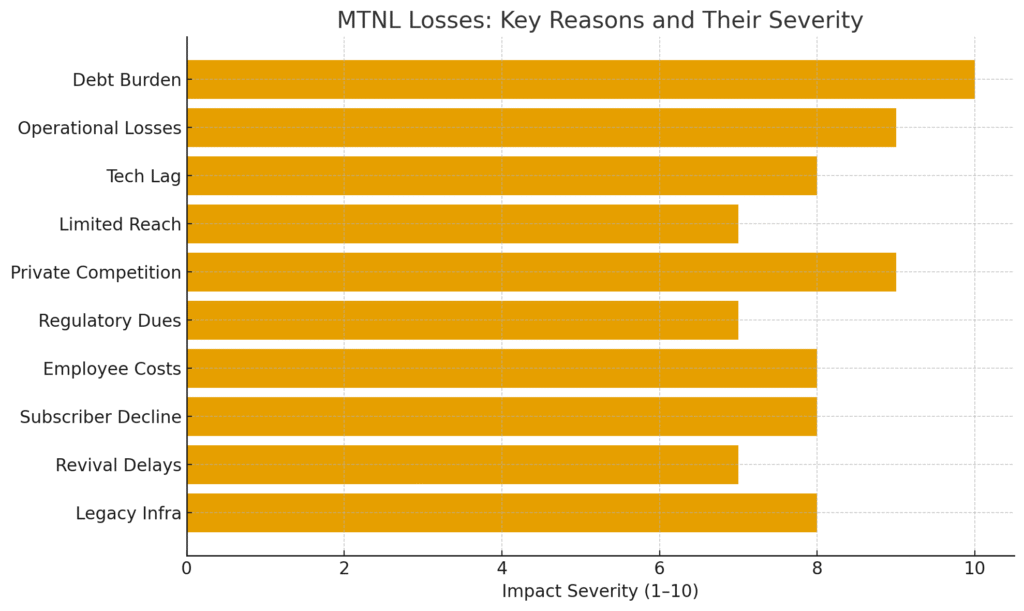MTNL is burdened with a massive debt of Rs. 34,484 crore as of June 30, 2025, including Rs. 8,585 crore in bank loans.
- Regulatory Dues, AGR Burdens, And Spectrum Charges Further Drain MTNL’s Already Fragile Financial Standing
- Employee Costs, Bureaucracy, And Market Limitations Keep MTNL Struggling In India’s Telecom Digital Era
NEW DELHI (India CSR): Mahanagar Telephone Nigam Limited (MTNL), once a pioneer in India’s telecommunications landscape, has been synonymous with innovation since its inception in 1986 as a Navratna public sector undertaking (PSU). Tasked with providing fixed-line and mobile services primarily in Delhi and Mumbai, MTNL symbolized the government’s push toward modernizing communication infrastructure. However, the winds of liberalization, fierce private competition, and internal mismanagement have transformed this telecom titan into a perennial loss-maker.
In its 39th Annual Report for FY 2024-25, MTNL reported a staggering net loss of Rs. 3,323.51 crores on total income of just Rs. 1,307.02 crores, with expenditures ballooning to Rs. 4,630.53 crores—a grim escalation from the previous year’s Rs. 3,302.19 crore loss.
This financial quagmire isn’t a sudden storm but a decades-long erosion, exacerbated by mounting debts, regulatory hurdles, and operational inertia.
As the government grapples with revival plans—including a service agreement with Bharat Sanchar Nigam Limited (BSNL) effective from January 2025 and asset monetization efforts—MTNL’s woes persist.
Drawing from the company’s annual disclosures, expert analyses, and recent financial scrutiny, we will delve into 10 detailed reasons behind MTNL’s chronic losses.
These factors paint a picture of a company caught between legacy burdens and a hyper-competitive market, offering insights into what it would take for a turnaround.
MTNL Losses: Key Reasons and Their Severity

***
1. Overwhelming Debt Burden and Loan Defaults
MTNL’s financial health is crippled by an insurmountable debt pile, totaling Rs. 34,484 crores as of June 30, 2025, including Rs. 8,585 crores in bank loans alone. This debt has snowballed over 12 years of recurring losses, leading to multiple defaults—five in recent counts—on principal repayments and interest obligations. The company’s inability to service these loans stems from cash flow shortages, forcing it into a vicious cycle where interest payments alone devour revenues. In FY 2024-25, despite government infusions exceeding Rs. 3.22 lakh crores into MTNL and BSNL since 2019, the debt remains unsustainable, prompting lenders like State Bank of India to threaten legal action. This not only erodes shareholder value but also blocks access to fresh capital, perpetuating the loss spiral.
***
2. Recurring Operational Losses and Negative EBITDA
Year after year, MTNL’s operations bleed red ink, with FY 2024-25 marking yet another net loss exceeding Rs. 3,300 crores. The gap between income (Rs. 1,307 crores) and expenditure (Rs. 4,630 crores) highlights a core inefficiency: operational costs far outstrip revenues. Negative EBITDA, driven by high fixed costs like employee salaries and maintenance, has persisted for over a decade, reflecting a failure to achieve economies of scale. Unlike agile private competitors, MTNL’s legacy infrastructure demands constant upkeep without proportional subscriber growth, turning everyday operations into a financial drain.
***
3. Inability to Invest in Network Upgrades and Technology
Financial distress has left MTNL starved of capital expenditure (CAPEX), stunting its ability to modernize networks amid the 5G revolution. The company’s handover of maintenance to BSNL in 2025 underscores this vulnerability—BSNL now bears CAPEX responsibilities, as MTNL lacks funds for upgrades. Over the past five years, MTNL’s delayed 4G rollout and absence in 5G spectrum auctions have alienated tech-savvy customers, leading to revenue stagnation. Without investment, service quality suffers, resulting in churn rates that exacerbate losses; analysts estimate this tech lag has cost MTNL billions in potential market share.
📊 Key Facts: MTNL’s Financial Struggle
| Particulars | Details (FY 2024-25) |
|---|---|
| Company Name | Mahanagar Telephone Nigam Limited (MTNL) |
| Year of Establishment | 1986 |
| PSU Status | Navratna PSU |
| Primary Markets | Delhi and Mumbai |
| Net Loss | ₹3,323.51 crore |
| Total Income | ₹1,307.02 crore |
| Expenditures | ₹4,630.53 crore |
| Debt Burden | ₹34,484 crore (including ₹8,585 crore bank loans) |
| Subscriber Base Decline | From 5 million (2010 fixed-line) to <1 million today |
| Revival Efforts | Service agreement with BSNL (2025), asset monetization, government bailouts |
4. Limited Geographic Reach and Market Confinement
Unlike national giants like Reliance Jio or Airtel, MTNL operates solely in Delhi and Mumbai, restricting its addressable market to about 5% of India’s 1.1 billion telecom subscribers. This hyper-local focus, a relic of its original mandate, limits revenue diversification and exposes it to regional economic fluctuations. In a market where scale drives profitability, MTNL’s confined footprint means it can’t leverage nationwide synergies, such as bulk spectrum deals or cross-selling. The result? A subscriber base that’s shrunk by over 50% in the last decade, turning what was once a monopoly into a niche player overshadowed by pan-India rivals.
***
5. Fierce Competition from Private Telecom Behemoths
The 1990s liberalization unleashed private predators like Bharti Airtel and Vodafone Idea, eroding MTNL’s market dominance through aggressive pricing and superior services. Jio’s 2016 entry with free data obliterated MTNL’s wireless segment, slashing tariffs by 90% and forcing unsustainable price matches. MTNL’s market share in mobile services plummeted from 20% in the early 2000s to under 2% today, as private players invested in data ecosystems while MTNL clung to voice-centric models. This competitive squeeze has halved revenues since 2015, with no counter-strategy in place to regain ground.
***

6. Regulatory Burdens: AGR Dues and Spectrum Charges
The Supreme Court’s 2019 Adjusted Gross Revenue (AGR) ruling saddled MTNL with dues exceeding Rs. 2,000 crores, payable in installments that strain its already fragile balance sheet. Coupled with annual spectrum usage charges and license fees—often 8-10% of revenues—these liabilities act as a regulatory chokehold. MTNL’s plea for waivers or restructuring remains unresolved, despite a Committee of Secretaries (COS) formed in 2025 to address such issues. These non-operational costs, unique to legacy PSUs, divert funds from growth, ensuring losses persist even as revenues flatline.
***
7. High Employee Costs and Bureaucratic Inefficiencies
As a government entity, MTNL grapples with a bloated workforce of over 20,000 employees, many on lifetime pensions, inflating salary and overhead costs to nearly 40% of expenses. The “Deemed Deputation Policy” approved in 2025 to shift staff to BSNL is a belated fix for underutilized manpower, but years of overstaffing have fostered inefficiencies—like slow decision-making and resistance to digital tools. Visits to MTNL offices reveal outdated processes, from manual billing to delayed query resolutions, deterring customers and inflating administrative losses. In contrast, private peers operate with lean teams, achieving 20-30% lower cost-to-revenue ratios.
***
8. Declining Subscriber Base and Customer Churn
MTNL’s fixed-line subscribers have dwindled from 5 million in 2010 to under 1 million today, driven by a shift to mobile and broadband alternatives. Wireless users, hit hardest by Jio’s disruption, fell 70% post-2016, with churn rates hovering at 15-20% annually due to poor network reliability. The company’s failure to pivot to value-added services like OTT bundles or enterprise solutions has left it reliant on eroding voice revenues, which now constitute just 30% of income. This subscriber hemorrhage directly correlates with a 25% revenue drop over five years, locking in structural losses.
***
9. Delayed and Ineffective Revival Initiatives
Government bailouts—totaling Rs. 69,000 crores for debt and equity since 2019—have been piecemeal, failing to address root causes. The 2024 BSNL service agreement, while outsourcing operations, shifts OPEX burdens without resolving debt, and asset monetization (e.g., real estate sales) remains mired in approvals. Proposals like selling stakes in joint ventures (MSITS) or closing subsidiaries (MTL) languish at the Department of Telecommunications (DoT), delaying liquidity. Critics argue this “rescue, repeat, regret” cycle—infusions without reforms—has eroded investor confidence, with MTNL’s stock value wiped out 100% since 2010 peaks.
***
10. Legacy Infrastructure and Obsolescence Risks
MTNL’s aging copper-based fixed-line networks, built in the pre-digital era, demand exorbitant maintenance amid declining usage. Upgrading to fiber optics or IP-based systems requires billions MTNL doesn’t have, leaving it vulnerable to obsolescence as India races toward a 6G future. Environmental and urban constraints in Delhi and Mumbai further hike costs for tower installations, while unmonetized real estate assets (e.g., unused buildings) sit idle. This infrastructural albatross not only inflates OPEX but also hampers service innovation, ensuring MTNL lags in a sector where agility is survival.
(India CSR)




















